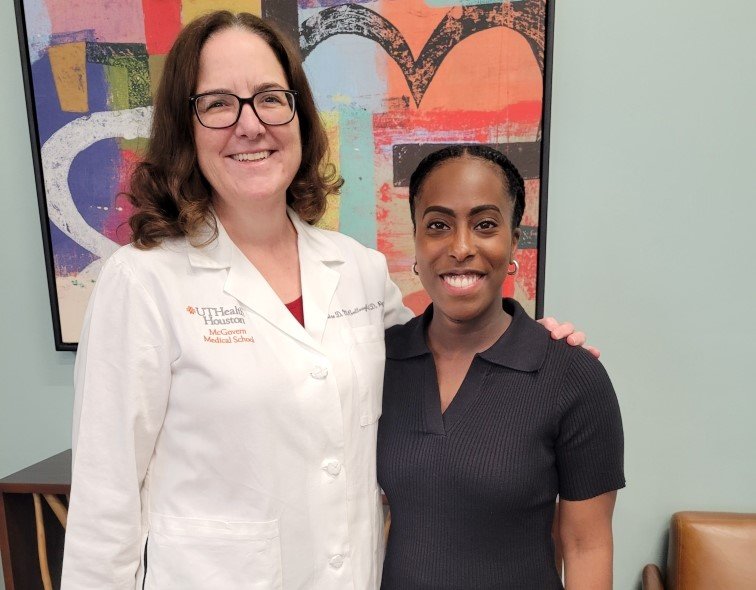Uncommon form of preeclampsia diagnosed, treated by UTHealth Houston physicians

Three years ago, Monique Dorsey had a textbook-perfect pregnancy. She brought home a beautiful baby girl, and everything seemed fine, except for some swelling on her feet, which she had read was normal.
But late at night, five days after delivery, she experienced what is called a thunderclap headache, which is severe and sudden and can warn of a life-threatening condition.
She tried a hot shower to relieve it, but the pain finally drove her to a nearby emergency center, where they diagnosed her with postpartum preeclampsia, prescribed medication, and sent her home.
Dorsey bought a blood pressure monitor, and when she got the headache a second time a short time later, she saw her blood pressure had skyrocketed. She headed back to the emergency room. This time, they scanned her brain and saw signs of narrowing of the blood vessels in her brain.
“I knew it was an abnormal headache. It felt very wrong,” Dorsey said. “They could see the narrowing and dissections in the blood vessels in my head.”
She was immediately transferred to Memorial Hermann-Texas Medical Center, where she met Louise McCullough, MD, PhD, professor and chair in the Department of Neurology and the Roy M. and Phyllis Gough Huffington Distinguished Chair. McCullough is also affiliated with The University of Texas MD Anderson Cancer Center UTHealth Houston Graduate School of Biomedical Sciences.
McCullough diagnosed her with a rare complication of preeclampsia called reversible cerebral vasoconstriction syndrome, or RCVS.
“RCVS causes spasm of the blood vessels in the brain, and her vessels were so narrowed that she did not get enough blood flow to an area of her brain and had a small stroke,” McCullough said. “We treated her blood pressure, and within a month, we were able to take her off the medication, and she completely recovered. It was all pregnancy related.”
Preeclampsia is a life-threatening condition marked by extremely high blood pressure that occurs after the 20th week of pregnancy. It affects 1 in every 25 pregnancies, according to the March of Dimes.
“What many people don’t realize is that 20% of preeclampsia cases occur after delivery,” McCullough said. “Black women are at a much higher risk, and the maternal mortality rate is three times higher and is closely linked to hypertensive disorders of pregnancy, including preeclampsia and eclampsia.”
Once Dorsey had a diagnosis, she said she and her husband asked a lot of questions.
“I was happy to have Dr. McCullough as a doctor,” Dorsey said. “She has an amazing bedside manner, and I appreciated how candid she was and how she took the time to explain everything to me.”
When Dorsey was pregnant with her second child late last year, she contacted McCullough for a plan in collaboration with Rachel Newman, MD, MBA, assistant professor of maternal-fetal medicine in the Department of Obstetrics, Gynecology, and Reproductive Sciences. Dorsey was placed on a baby aspirin regimen and then, during the end of her pregnancy, she was prescribed an anticoagulant medication.
As before, the pregnancy was complication-free, and Dorsey delivered another baby girl. But at the same point as before, five days after delivery, Dorsey called McCullough and Newman to say her blood pressure was up and she had a headache.
Dorsey was admitted to the hospital, and after she failed to respond to other hypertensive medications, she was placed on a calcium channel blocker, which lowered her blood pressure.
“I had very quick access to Dr. Newman and Dr. McCullough, and they were working together to make sure it didn’t progress like the first one,” Dorsey said. “I still had to go into the hospital, but because of the monitoring, it was caught way before it got as bad as the first time.”
She did not suffer a stroke this time and, after six weeks, was able to stop taking the blood pressure medication. For Dorsey, the preeclampsia with accompanying high blood pressure was strictly the result of pregnancy hormones.
Dorsey was willing to share her story to encourage other women to listen to their bodies and speak out when they feel like something is not right.
“Women should really ask questions and not be afraid to let the doctor know when something doesn’t feel normal. I knew it wasn’t a normal headache,” Dorsey said. “I want women to know they should advocate for themselves. Get a blood pressure monitor — put it on your registry along with the diapers and all of that — and monitor not just during pregnancy, but after.”